Choosing the right email marketing platform can significantly impact your startup’s growth. With countless options claiming to offer everything, it’s easy to get lost in the noise.
I’ve analyzed 11 of the top email marketing software for startups to help you make an informed decision.
This guide breaks down each tool’s strengths and the factors that matter most when choosing the best option for your business.
So, let’s get into it.
P.S. All written is relevant to the time of publishing
Best email marketing software for startups: a snapshot
- Mailtrap Email Delivery Platform is best for product companies with high volume email sending with focus on high inboxing rate and in-depth email analytics.
- Brevo: a marketing and CRM platform with tools to automate email campaigns, manage customer relationships, and run multichannel campaigns across email, social media, and ads.
- HubSpot: a comprehensive inbound marketing and CRM platform that integrates email marketing, automation, and customer relationship management to help businesses grow and scale.
- Venturz: an all-in-one platform built specifically for startups. It provides comprehensive email marketing tool focused on growth.
- Mailchimp: great for startups seeking a cost-effective and accessible tool to manage both simple and advanced email marketing campaigns.
- MailerLite: designed for startups that prioritize ease of use and need a simple, intuitive platform to create and send beautiful, professional emails.
- SendX: An email marketing software that allows you to send unlimited email campaigns, build your email lists, and automate advanced email sequences.
- GetResponse: email and marketing automation platform designed for startups, solopreneurs, and small business owners.
- Moosend: best for budget-conscious startups that need a straightforward, no-frills email marketing service with solid marketing automation tools.
- Benchmark Email: a straightforward tool for startups to create and manage email campaigns.
- Mailercloud: a simple, intuitive platform designed for startups and enterprises to create and send professional emails with advanced automation and analytics features. Ideal for teams seeking a reliable, user-friendly email marketing solution that scales with business growth.
*I’ve calculated the prices based on sending 10,000 emails per month to a contact list of 2,000 addresses. These prices are current as of November 2024.
| Platform | Free plan limits (emails/mo) | Pricing*(in US $) | Email deliverability focus |
| Mailtrap | 4,000 | 15 | ★★★★★ |
| Brevo | 9,000 | 29 | ★★★★★ |
| HubSpot | 2,000 | 32.5 | ★★★★☆ |
| Mailchimp | 1,000 | 56.53 | ★★★★☆ |
| MailerLite | 12,000 | 25 | ★★★☆☆ |
| SendX | 14-day trial | 7.49 | ★★★★★ |
| GetResponse | 2,500 | $29 | ★★★★☆ |
| Moosend | 30-day trial | 15.20 | ★★★☆☆ |
| Benchmark Email | 30-day trial | 30 | ★★★☆☆ |
| Mailercloud | 12,000 | 7 | ★★★★☆ |
Startups’ email marketing software comparison criteria
To find the best email marketing software for startups, I evaluated key factors like functionality, pricing, and user experience. I also tested each platform’s marketing tools and email tracking features to ensure they fit the demands of a startup’s email marketing strategy.
Here are the features I compared:
Email infrastructure
I checked each platform’s deliverability, reliability, and scalability features to ensure they met startups’ specific needs.
Deliverability: Ensuring high deliverability is crucial for keeping your emails out of spam folders. I picked platforms that prioritize deliverability by offering features like:
- Email authentication (DKIM, SPF, DMARC) to verify trusted sources.
- Bounce and spam complaint monitoring to protect your sender reputation and improve your customer relationship.
- Real-time notifications for instant insights into issues like bounces or unsubscribes.
- Email segmentation to target specific audiences for better engagement and customer relationship management.
- A/B testing to optimize subject lines, email content, and timing for improved performance.
Reliability: A reliable platform ensures your emails are sent without disruption, even during peak times. I focused on platforms with high uptime and minimal outages, supported by features like:
- Redundant infrastructure to prevent downtime by using multiple data centers.
- Scalable infrastructure to handle increasing email as startups grow.
- Backup storage systems to guarantee email delivery, even during temporary outages.
- Real-time monitoring and alerts to identify and address issues immediately.
- 24/7 customer support to resolve technical problems quickly.
Scalability: As your startup expands, so does the need for a scalable email infrastructure. Platforms that adapt to your needs provide affordable ways to increase email-sending capacity as you grow. I only picked providers with the ability to:
- Provide tiered pricing plans so startups can start small and scale as they gain more subscribers.
- Support high-volume sending to handle increased email traffic without any performance issues.
- Offer flexible plans, allowing you to adjust your usage as needed without facing high costs.
Pricing
Startups must manage costs closely, so I carefully evaluated each platform’s pricing structure. I compared free plans, the features available at each tier, and any limitations you might face when using a platform.
As your startup expands, costs can increase with more subscribers or advanced features. I also looked at how features are unlocked at different pricing levels to highlight any potential extra charges for essential tools.
Note: Pricing structures vary across providers. To avoid unexpected charges, pay close attention to areas like email volume and the cost of additional features. Look for services that have clear pricing, flexible plans, and straightforward feature upgrades.
Marketing email sending
I settled only for platforms that make email creation and marketing automation easy for startups. Automation workflows let you set up recurring campaigns without the need to send them manually.
Another critical aspect is email list segmentation which allows you to categorize subscribers based on their demographics, behaviors, and engagement levels. This, combined with dynamic content, ensures you’re delivering the right message to the right audience.
For example, this email would only be effective if your target audience lives in places where autumn is traditionally cold.

An intuitive email builder is also necessary, especially if you’re a beginner and don’t have design experience. Drag-and-drop functionality makes it easy to design emails from scratch, while the HTML editor allows you to import any pre-existing designs.
Managing your email list is also important — keeping it clean and up-to-date through features that remove inactive subscribers, bounces, or those who have opted out.
Another key feature I evaluated is A/B testing, which helps you fine-tune your emails to get better campaign performance. Testing different versions of your emails helps you optimize for what works best. This can include experimenting with content, design, or timing.
Note: Many of these advanced tools may only be available on higher-tier subscriptions.
Email design
Your email design is often the first thing your audience notices, so I tested each platform’s email builder to see how easily it is to create visually appealing campaigns without design experience. A good builder should be intuitive, versatile, and allow for customization through drag-and-drop functionality, pre-designed templates, and the ability to edit HTML for advanced users.
For example, here’s the email design I created in Mailtrap in just a few minutes. I know it’s not perfect, but I’m proud to say I did it myself!
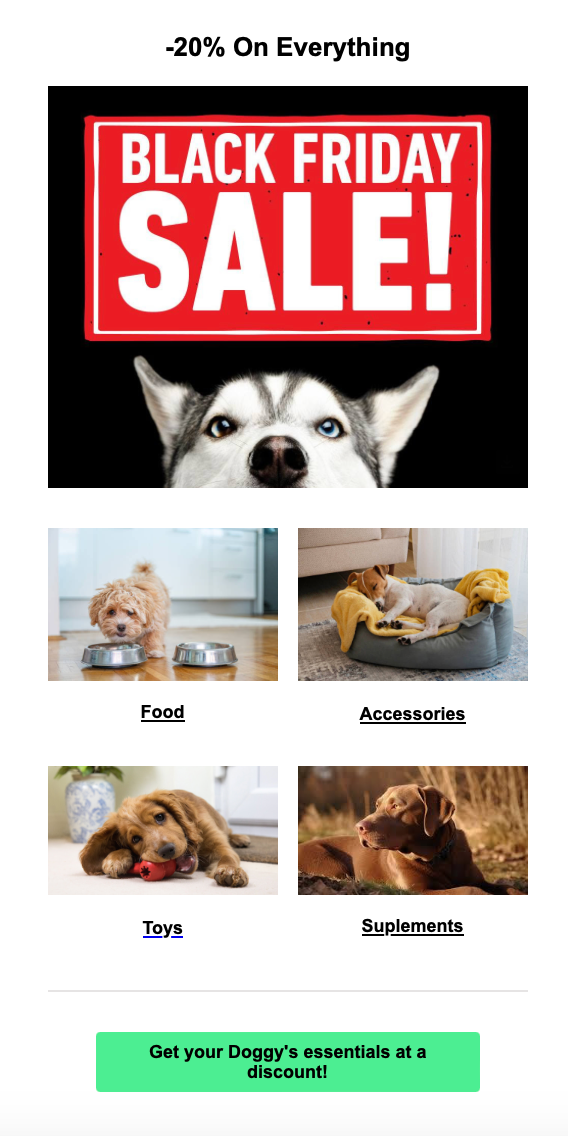
I also assessed the variety and quality of templates available to ensure that you can choose from modern, mobile-responsive designs that fit your brand. Beyond templates, the email editor should offer high flexibility. This will allow you to make adjustments or create custom emails from scratch.
Email automation and integrations
I also evaluated each platform’s ability to set up workflows for tasks like welcome emails, drip campaigns, and abandoned cart reminders. It’s also important to know if your mass email provider lets you handle email blasts automatically, with minimal manual work.
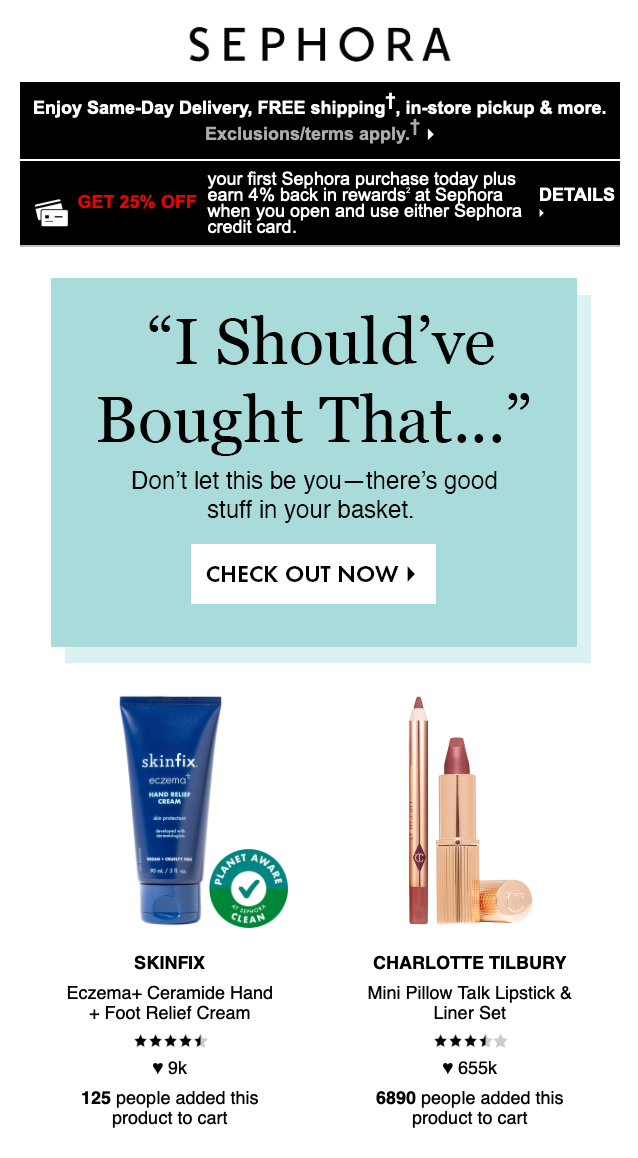
A strong automation feature saves time and ensures consistent communication with your audience.
In addition to automation, I checked for integrations with other tools startups might use, such as CRM systems and eCommerce platforms. These integrations allow seamless customer data sharing and help streamline your marketing efforts across multiple channels.
User experience
I placed a strong emphasis on ease of use, especially for startups that don’t have the time or resources to train extensively on new makerspace software. I checked how intuitive the interface is, whether it’s easy to navigate, and how quickly you can get your first campaign off the ground.
Also, I reviewed the quality of onboarding support each platform provides: an individual demo of the product, step-by-step text or video tutorials, live chat support, or in-depth knowledge bases.
Customer experience
Lastly, I was very curious to see what real users had to say about each platform. After all, most B2B buyers agree that reviews from real users are one of the most trustworthy sources when evaluating software.
I reviewed testimonials and ratings from other startups and small businesses. I especially paid attention to users’ comments on platforms like Reddit and Quora.
For example, Mailtrap Marketing Hub has received many positive reviews on Reddit from users who appreciate its features and ease of use.
Also, I reviewed ratings from trusted sources like G2 and Capterra to get a more comprehensive view of how these platforms perform in practice.
Platforms with consistently high customer satisfaction, responsive support teams, and positive user experiences in real-world situations received better scores. Plus, testimonials from similar businesses can be a smart way to gauge how the platform performs under the pressures of startup life.
Best email marketing provider for startups: Mailtrap Email Delivery Platform
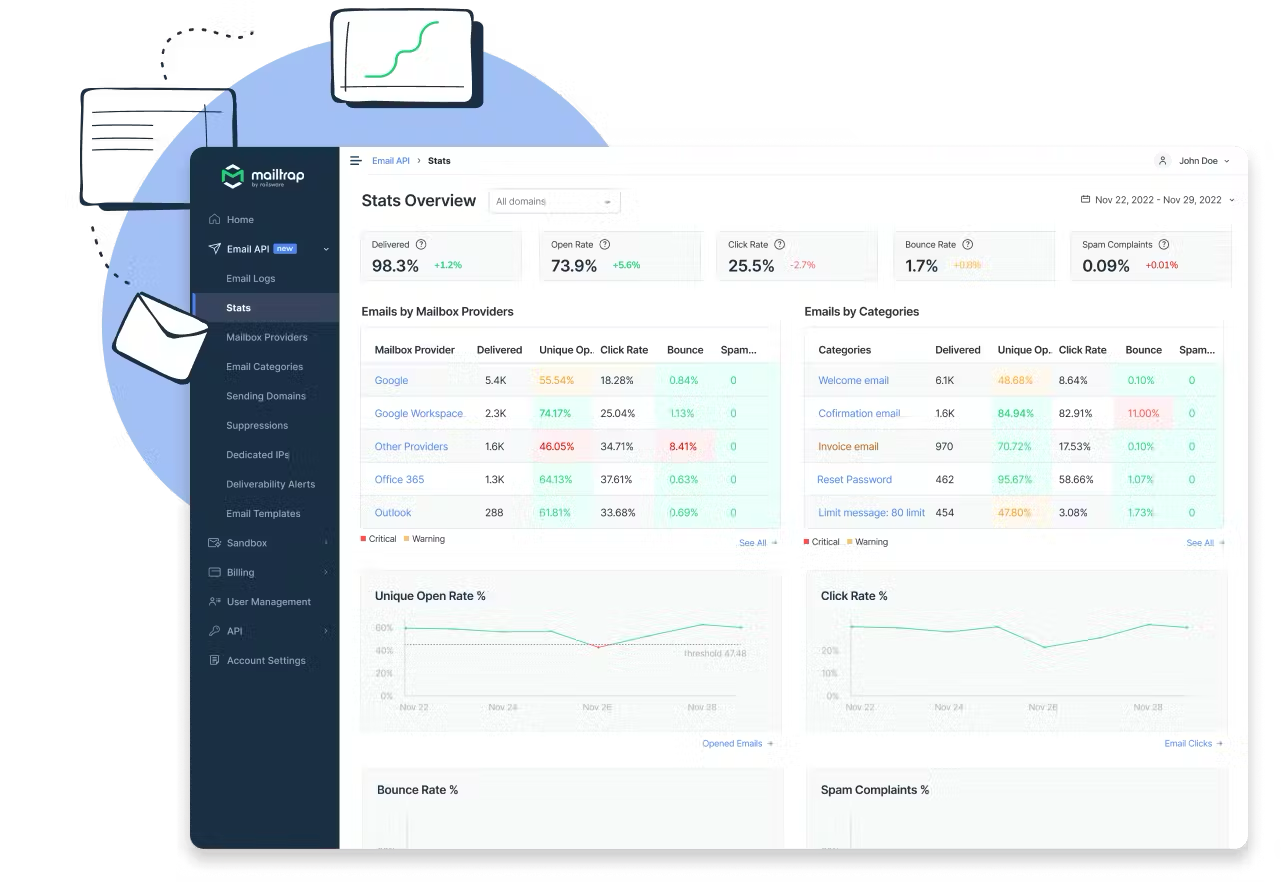
Mailtrap Email Delivery Platform is designed for high-volume sending product companies.
It’s perfect for fast-growing startup’s marketing teams if you focus on high email deliverability, growth-focused features, and in-depth email analytics.
It provides an intuitive drag-and-drop email builder, HTML email editor, library of email templates, and top-notch email list management.
What sets Mailtrap apart is its emphasis on email delivery. To demonstrate Mailtrap’s commitment to high deliverability, I ran a test using GlockApps, which showed that more than 90% of transactional and marketing emails sent via Mailtrap land directly in the inbox or relevant tabs, with less than 6% being sent to secondary tabs.
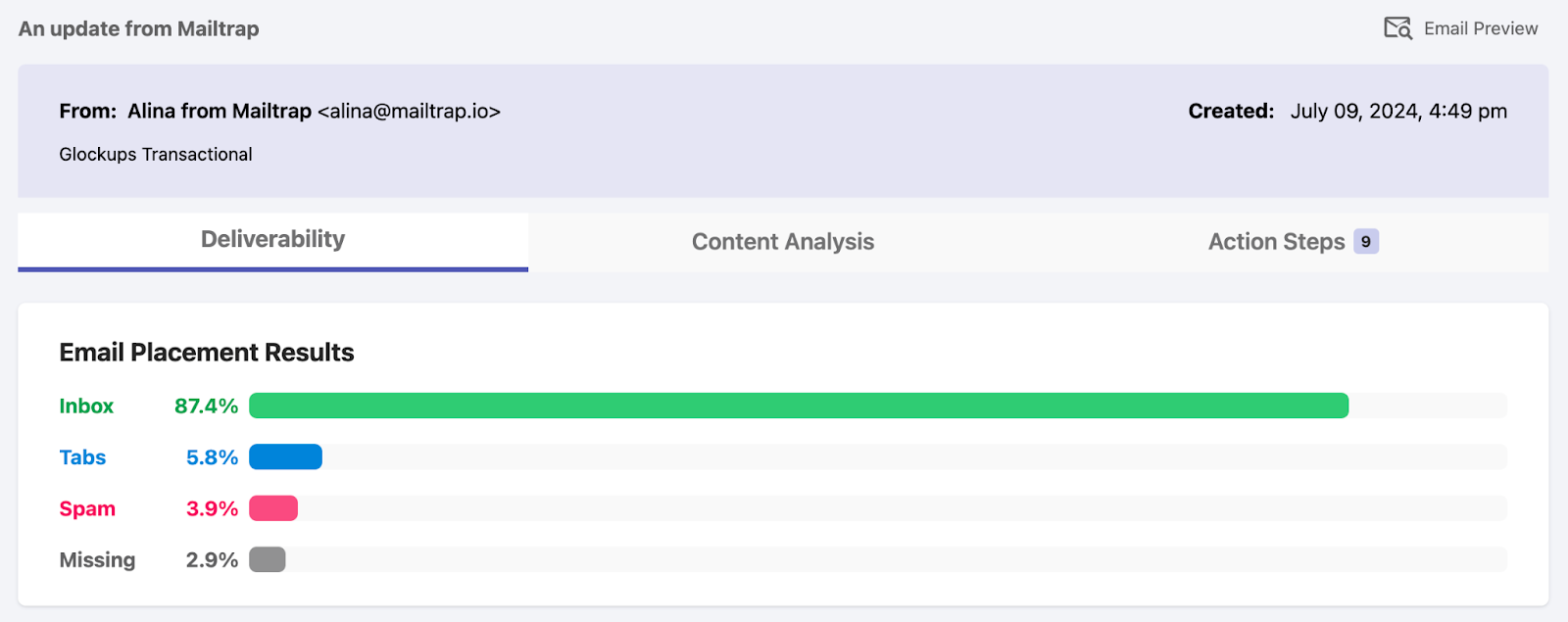
Pricing
Mailtrap’s free plan allows you to send up to 4,000 emails per month, which is ideal for startups (as far, as I could judge).
However, our most popular tier for large-volume senders is Business plan, starting at $85. It includes 100,000 contacts, dedicated IP, auto IP warmup, deliverability team support, and much more. You can check all the details on the pricing page here.
Pros
- Reliable solution to send email marketing campaigns with an emphasis on deliverability.
- Easy to use drag-and-drop email template, HTML editor, and pre-designed email templates.
- GPDR compliance and ISO 27001 certification.
- Email campaign scheduler.
- Comprehensive drill-down reports, real-time analytics, and insightful data dashboards.
- Affordable, scalable plans with rich functionality even in the free plan.
Cons
- API-first approach to integrations: most of integrations are doable through Zapier, Make, or n8n.
Brevo (formerly Sendinblue)
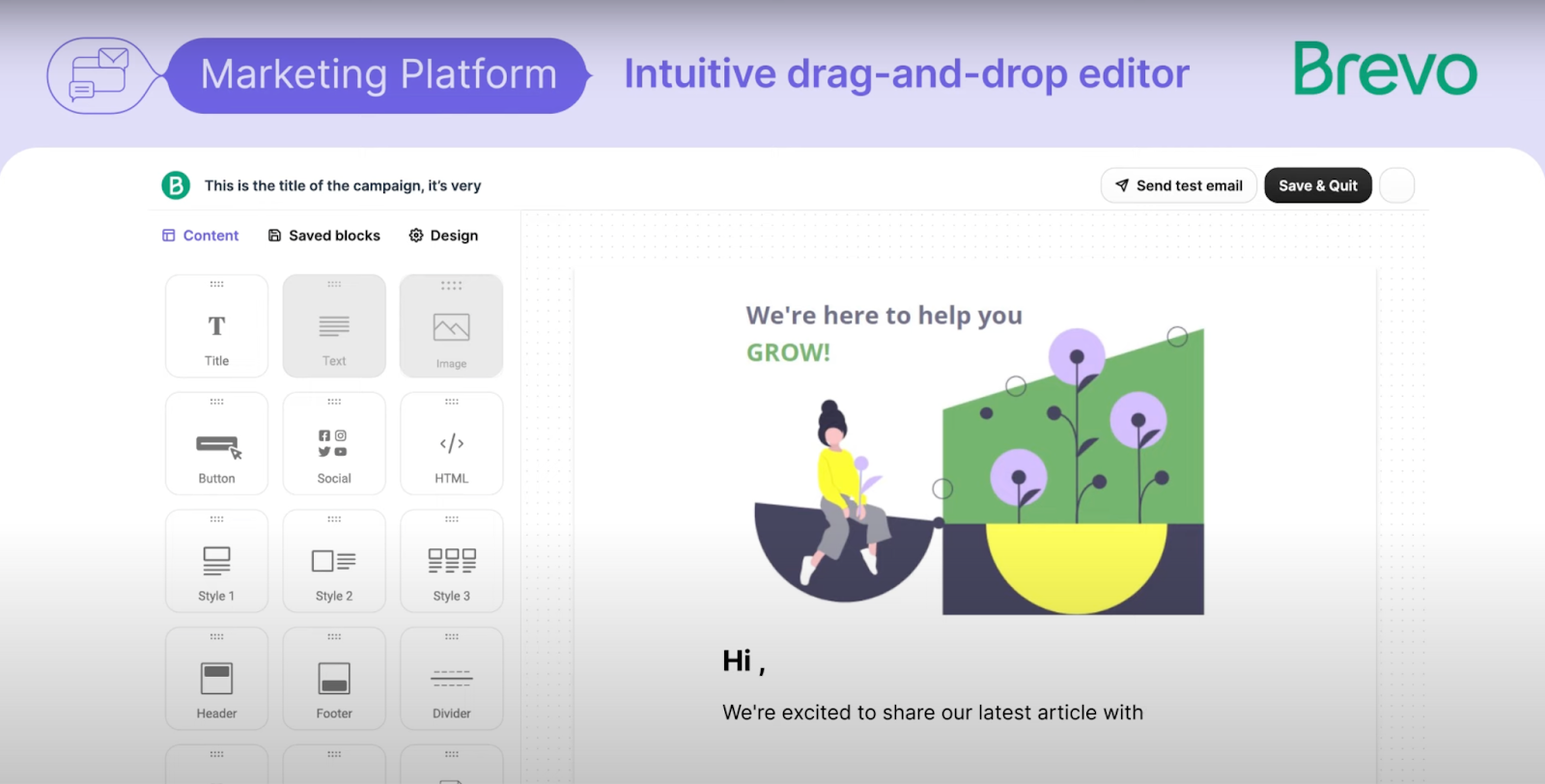
Source: Brevo
Brevo is a comprehensive solution for startups that heavily rely on two-way communication. The platform masters omnichannel communication and allows you to reach your audience via email, SMS, WhatsApp, and push notifications.
Also, Brevo offers users convenient and robust email automation features to create sequences of emails using multiple triggers and user behavior patterns. To create emails, you can use an intuitive drag-and-drop template builder.
For sales teams, Brevo has a CRM solution that also has a range of workflow automation scenarios one can use to streamline routine processes. It also integrates seamlessly with popular CMSs, e-commerce platforms, and CRMs, ensuring smooth data flow across all customer touchpoints.
Pricing
Brevo offers a free plan with unlimited subscribers and a daily limit of 300 emails. The paid tier starts at $8.08 per month (when billed annually), including 5K emails, no Brevo branding, customer support, and basic analytics. For the latest plans and pricing, visit the official website.
Pros
- Brevo has an intuitive design that makes it easy for marketers to navigate and manage campaigns.
- It provides a robust set of tools for creating and managing email marketing funnels effectively.
- You can set up automated workflows to send targeted emails and messages based on user behavior and triggers.
- The platform supports multiple languages, catering to a diverse user base.
- Ability to reach and communicate with customers via multiple channels.
Cons
- Brevo’s email templates are more basic than those of competitors, which may require extra customization to achieve a polished look.
- Response times for customer support can be slower than expected.
- Analytics are limited on lower-tier plans.
HubSpot Marketing Hub

HubSpot is one of the most popular email marketing software solutions for startups because it offers all essential marketing tools in one platform.
With HubSpot, startups can support various marketing channels without the need for multiple software tools. Its all-in-one setup includes content management, SEO tools, detailed analytics, and automation features, including follow-up emails, audience segmentation, lead scoring, and workflows to guide potential customers through the sales funnel.
HubSpot also offers a range of plugins and built-in integrations, such as WordPress and Shopify, that simplify setup. The platform’s onboarding resources, including step-by-step guides, templates, and in-app tips, make it user-friendly, even for those with limited technical expertise.
Pricing
HubSpot offers several pricing tiers to accommodate different business needs. Startups can take advantage of the free plan, which includes email marketing, forms, contact management, and basic reporting. HubSpot also gives you the option to use its core email marketing tools independently, completely for free.
For those who need more advanced features, HubSpot’s Marketing Hub Starter plan begins at $20 per month and offers additional tools like list segmentation and email automation.
Pros
- Offers a comprehensive suite of digital marketing, sales, and customer service tools.
- Free plan provides access to essential features for starting your email marketing efforts.
- User-friendly drag-and-drop email builder
- Intuitive platform requires minimal training, ideal for startups with limited marketing experience.
- Automation tools streamline workflows, reducing the time and effort for campaign monitoring.
- Simplified tracking of key metrics like open rates and click rates.
Cons
- The free tier lacks some customization options, such as split testing and advanced analytics.
- While easy to use at the basic level, some of HubSpot’s advanced automation features can take time to master.
Venturz
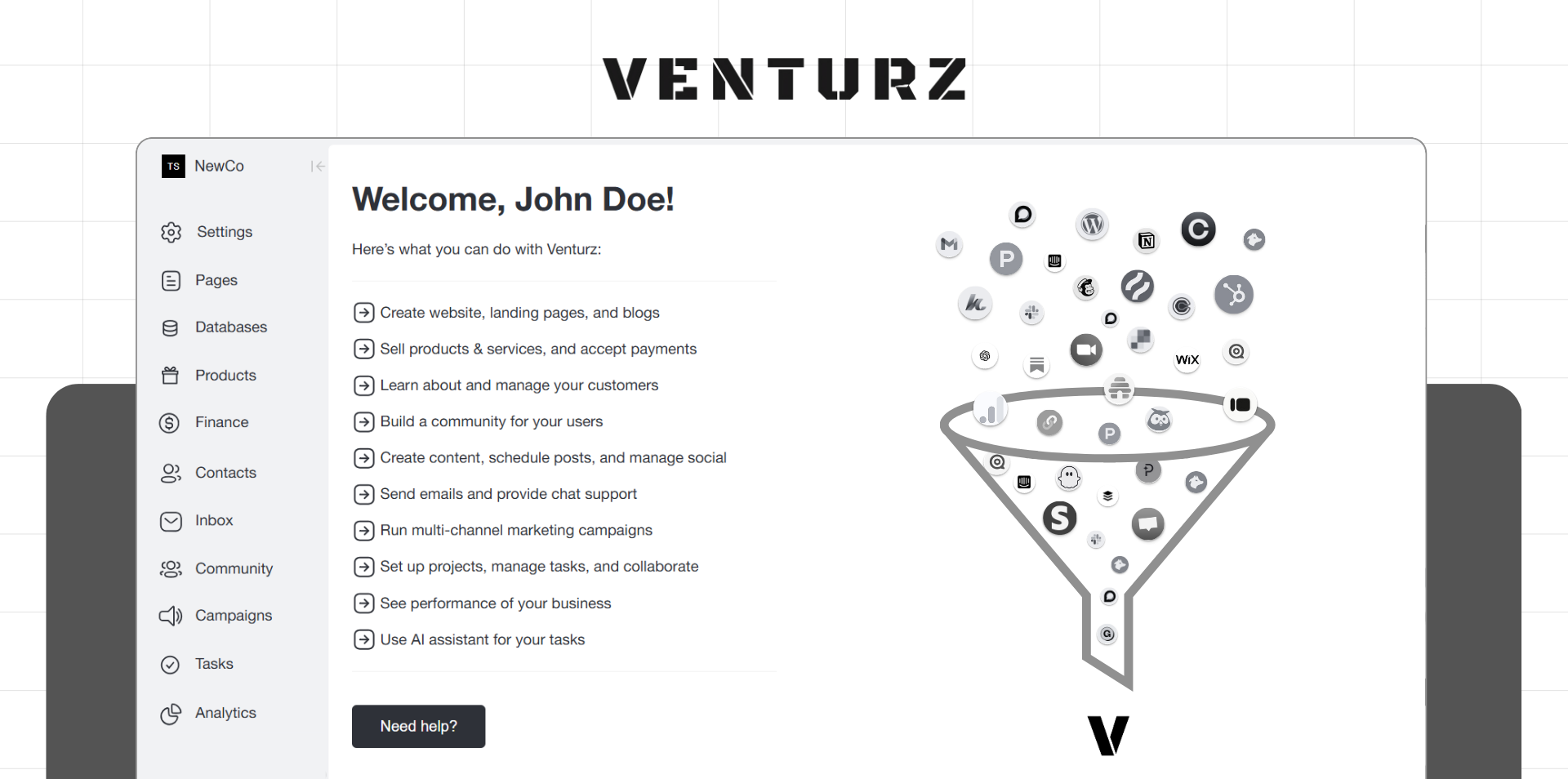
Venturz is a powerful all-in-one platform designed specifically to help startups build, grow, and scale their entire digital presence — from marketing and sales to community building and fundraising. Where most email platforms stop at automation, Venturz extends your reach with a full stack of startup tools including CRM, landing page builders, email marketing, content publishing, collaboration tools, and even investor management — all in one unified interface.
What sets Venturz apart is its deep integration of growth-focused features. You can easily design custom email campaigns, build automated funnels, and manage subscriber journeys without jumping between apps. The visual funnel builder, drag-and-drop email editor, and prebuilt startup templates make it incredibly intuitive — even for non-technical founders.
Venturz also includes a built-in CRM, live chat, project management, and community tools — turning your email campaigns into just one part of a cohesive startup engine. Whether you’re nurturing leads, managing teams, hosting webinars, or launching your product, Venturz is purpose-built to support startups from idea to scale.
Pricing
Venturz offers a generous free plan for early-stage founders with access to core tools like CRM, email marketing, and page builders. Paid plans start at $29/month, unlocking advanced automation, integrations, team collaboration features, and investor tools — all with no need for third-party add-ons.
Pros
- All-in-one solution: CRM, email, automation, community, analytics, and fundraising in one place.
- Powerful email marketing tools with A/B testing, automation workflows, and segmentation.
- Visual sales funnel builder with drag-and-drop logic.
- Fully customizable landing page and website builder.
- Tools for investor management, community growth, and team collaboration.
- Supports custom email domains
- Real-time email tracking: opens, clicks, deliveries.
- Fast, reliable customer support via live chat and email.
Cons
- Fewer third-party integrations
- No support for SMS or WhatsApp messaging
Mailchimp (formerly Mandrill)
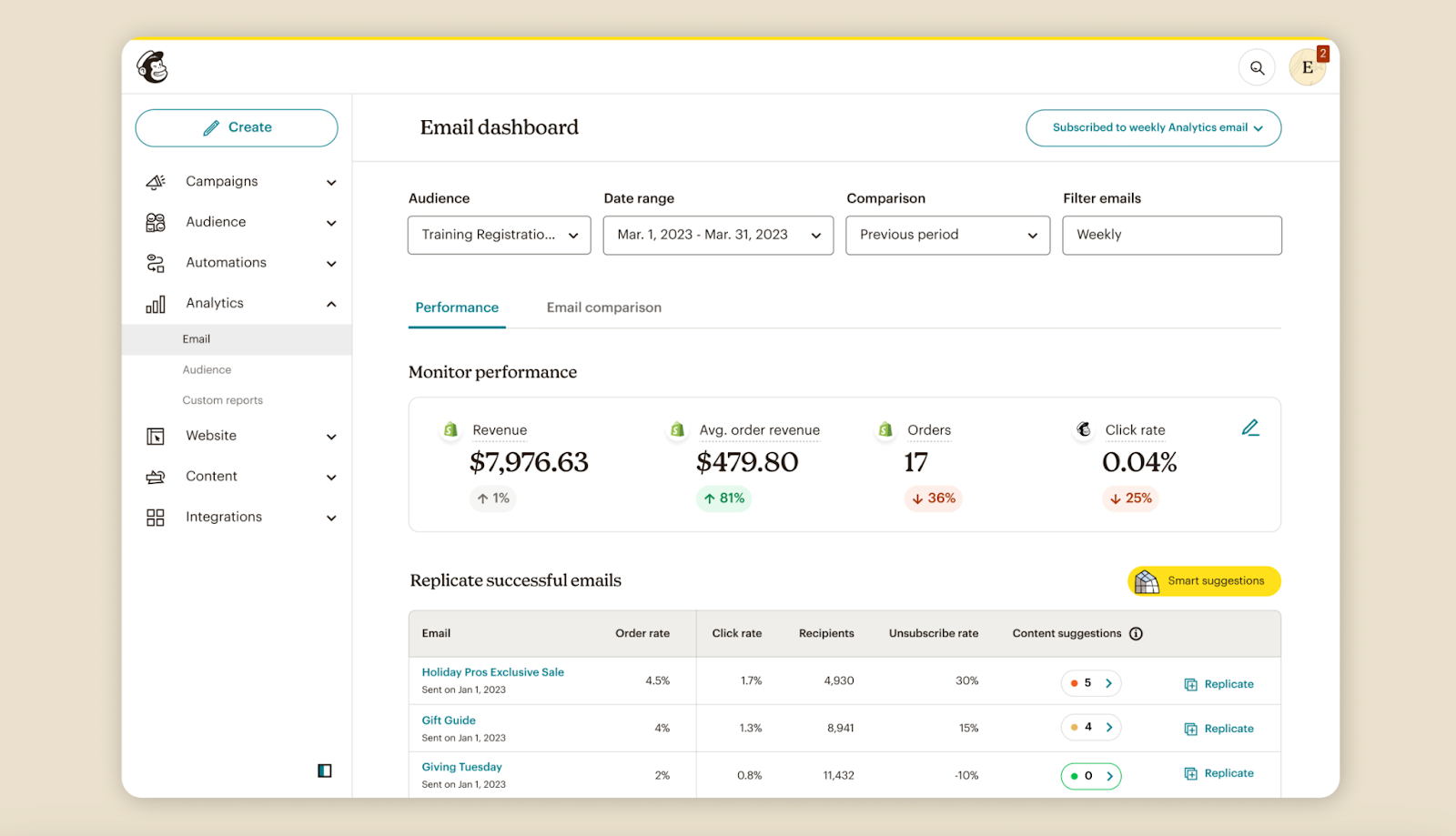
Mailchimp is a user-friendly platform ideal for small startups, particularly those in eCommerce aiming to build email lists and engage customers with targeted messaging.
Mailchimp offers a bunch of tools to automate email workflows triggered by actions like sign-ups, purchases, or abandoned carts. Also, it allows for delayed campaigns that let you send timely, targeted emails. The platform offers advanced list segmentation and custom sign-up forms to help marketers effectively target specific audiences. Also, users get detailed analytics to track and improve their future campaign performance.
Pricing
MailChimp’s free plan allows you to send up to 10K emails per month to a maximum of 500 contacts. However, emails sent with this plan will display Mailchimp’s branding in the footer.
The paid plans start at $10 per month for the first year (increasing to $20 per month in the second year) and include 6,000 emails with 500 contacts. Mailchimp frequently offers bonuses and discounts, so check their website for the latest prices and deals.
Pros
- The free plan.
- Flexible pricing with multiple tiers. Frequent special deals and discounts.
- Customizable templates
- Mailchimp’ simple integration with platforms like Shopify, WordPress, and social media.
Cons
- The analytics in lower-tier plans may not provide enough detail for startups that heavily rely on email marketing.
- Free plans don’t include customer support, and even premium plans may have slower or less effective support, especially for technical issues.
- It can get expensive for users who need to send a large volume of emails.
MailerLite
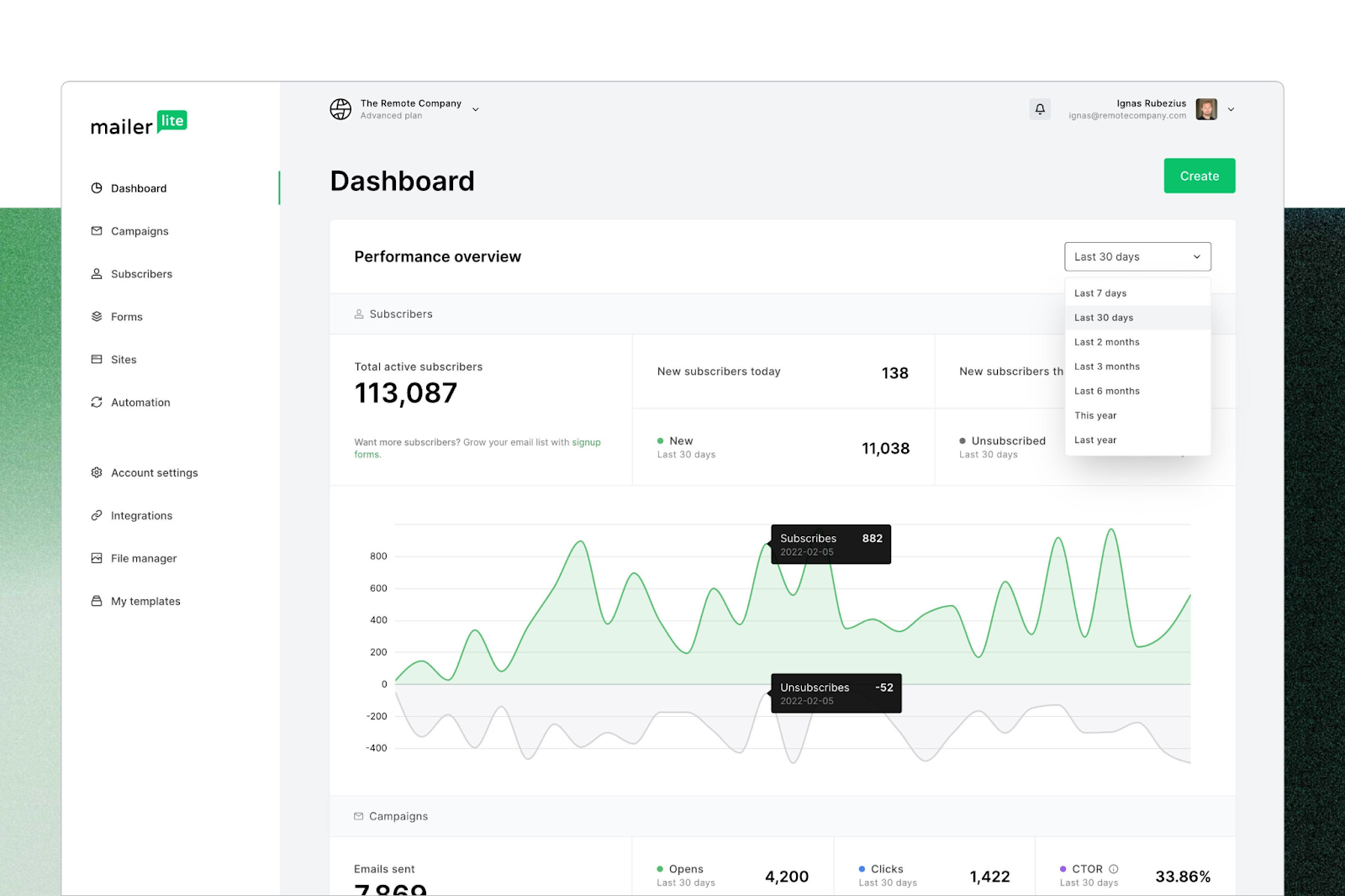
MailerLite is an email marketing tool that encourages creativity and brand personalization. It’s perfect for startups and solo entrepreneurs who want to prioritize aesthetic appeal in their campaigns.
The platform lets users send customized email campaigns, create branded landing pages, and design pop-ups and forms to capture new leads. With a user-friendly drag-and-drop editor and advanced segmentation options, MailerLite makes it easy to build engaging, visually appealing campaigns. And built-in analytics provide insights to help startups refine their strategies over time.
Another great feature is the ability to add interactive features like quizzes, surveys, carousels, and accordions to emails. These clickable elements motivate users to engage, leading to higher email interaction and improved metrics such as click-through rates (CTR).
Pricing
You can use MailerLite for free if you have up to 1K contacts and intend to send fewer than 12K emails monthly. It also includes essential tools like a drag-and-drop email editor, basic email marketing automation, and simple landing pages.
The paid plan starts at $9 per month for 500 contacts with unlimited emails. MailerLite’s tiers are highly customizable, scaling up to accommodate 500,000 contacts and 6 million emails per month.
Pros
- MailerLite prioritizes beautiful, visually appealing emails, making it perfect for startups that want to establish a unique brand identity.
- The drag-and-drop editor for quick and easy email design creation.
- Offers a variety of professional-looking templates that can be easily customized to match your brand’s identity.
- Has a range of automation options to set up welcome emails, follow-ups, etc.
- Simple integration with popular platforms like Shopify, WordPress, and others.
Cons
- Limited reporting features on lower-tier plans.
- Some users report inconsistent email deliverability rates, which can impact the effectiveness of campaigns.
SendX

Source: SendX
SendX is an all-in-one email marketing platform designed for high-volume businesses that want to maximize their ROI from email marketing. The platform offers AI-powered email marketing with automation workflows, audience growth tools including smart popups and forms, and a proprietary deliverability engine for superior inbox placement.
SendX provides users with a comprehensive email creation ecosystem with 1000+ professionally designed templates and an intuitive drag-and-drop editor. Its automation capabilities allow marketers to build complex customer journeys with a visual workflow editor and leverage advanced personalization based on subscriber behavior. For improving campaign performance, the platform offers heatmap reports, interactive email elements, and optimization tools like Geo-send and Smart Send.
The platform seamlessly integrates with popular e-commerce platforms (Shopify, WooCommerce), payment processors (Stripe, PayPal), and thousands of other applications through Zapier. For more technical users, SendX offers API SDKs and webhooks for custom integrations.
Pricing
SendX offers a 14-day free trial. Their pricing is based on list size with unlimited email sends rather than email volume caps.
Plan starts at $7.49/month (billed annually) for up to 1,000 contacts, $14.99/month for up to 2,500 contacts, and $29.99/month for up to 5,000 contacts. They also offer a SendX Plus plan with advanced features like dedicated IP addresses, 24/7 priority support, and dedicated account managers
Pros
- Excellent customer support with quick responses through chat
- Strong email delivery system that helps emails reach inboxes, not spam folders
- Easy-to-use automation tools with visual editor
- Personalized emails based on subscriber behavior
- Interactive email features like countdown timers
- Automatic list cleaning to remove bad email addresses
Cons
- Focuses mainly on email rather than text messaging or other channels
- May need to upgrade to SendX+ for advanced delivery support
GetResponse
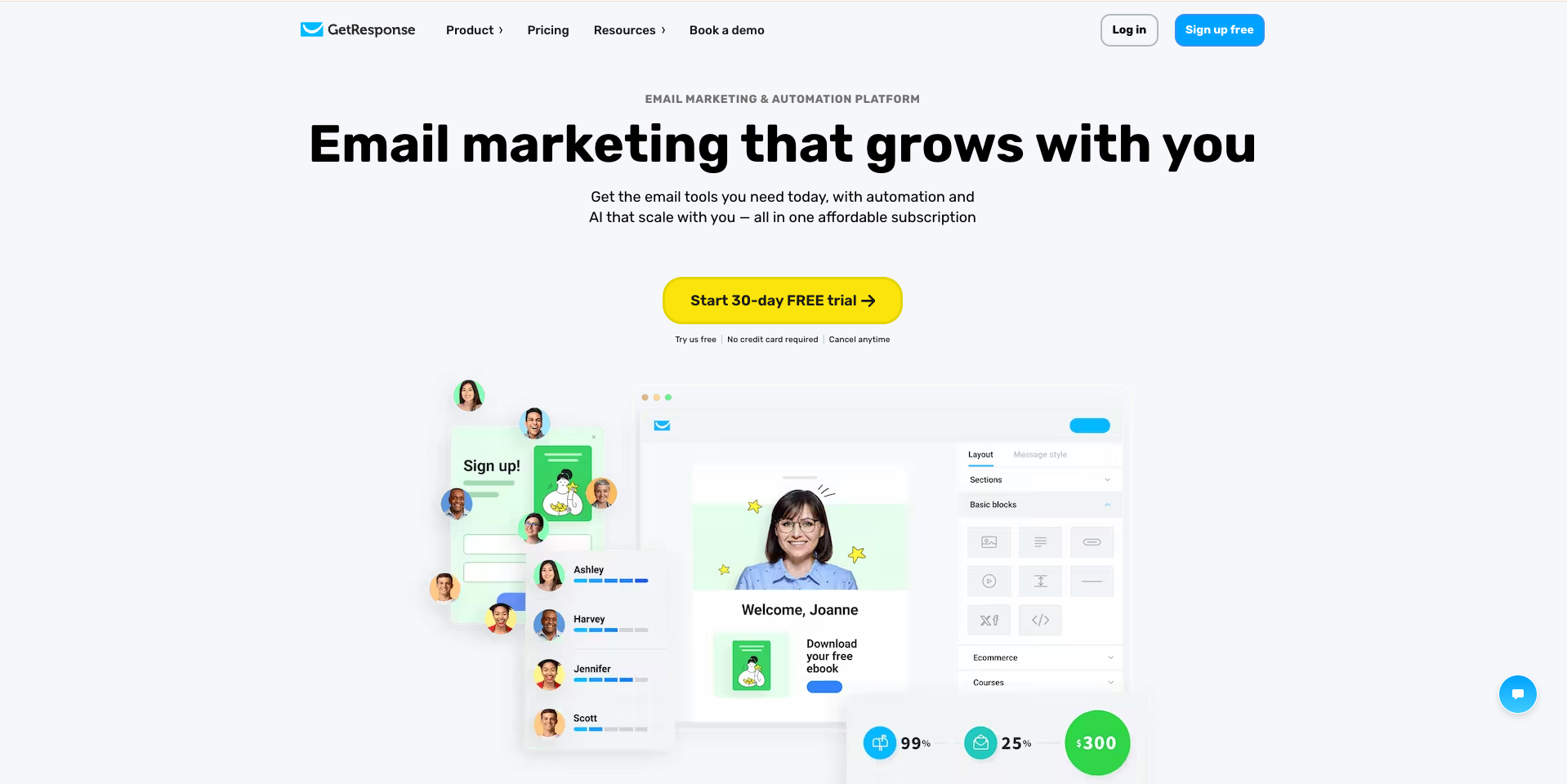
GetResponse is an email and marketing automation platform designed to empower startups, solopreneurs, and small business owners with comprehensive, scalable, and easy-to-use tools to grow, engage, and convert their audience.
Beyond email marketing, it offers powerful automation, list growth, and content creation tools, making it an ideal solution for those aiming to build their personal brand, sell products and services, nurture their audience, and build a community.
Pricing:
GetResponse offers a free plan that allows you to store up to 500 contacts and send 2,500 emails per month. It includes essential email marketing features and unlocks premium tools for the first 30 days.
The Starter plan begins at $19/month and includes unlimited email sends, landing pages, and basic automations. The Marketer plan, at $29/month, adds powerful features like unlimited marketing automation, advanced segmentation, and web push notifications. For $49/month, the Creator plan introduces webinars and online course capabilities. For larger needs, a custom-priced Enterprise plan is also available.
Pros:
- Offers a comprehensive set of tools under one roof.
- User-friendly interface suitable for non-technical users.
- Robust automation and segmentation capabilities.
- Great for lead generation thanks to built-in popups, landing pages, and webinars.
- 24/7 customer support with personalized onboarding.
Cons:
- SMS available only on the Enterprise plan.
- No built-in WhatsApp integration.
Moosend
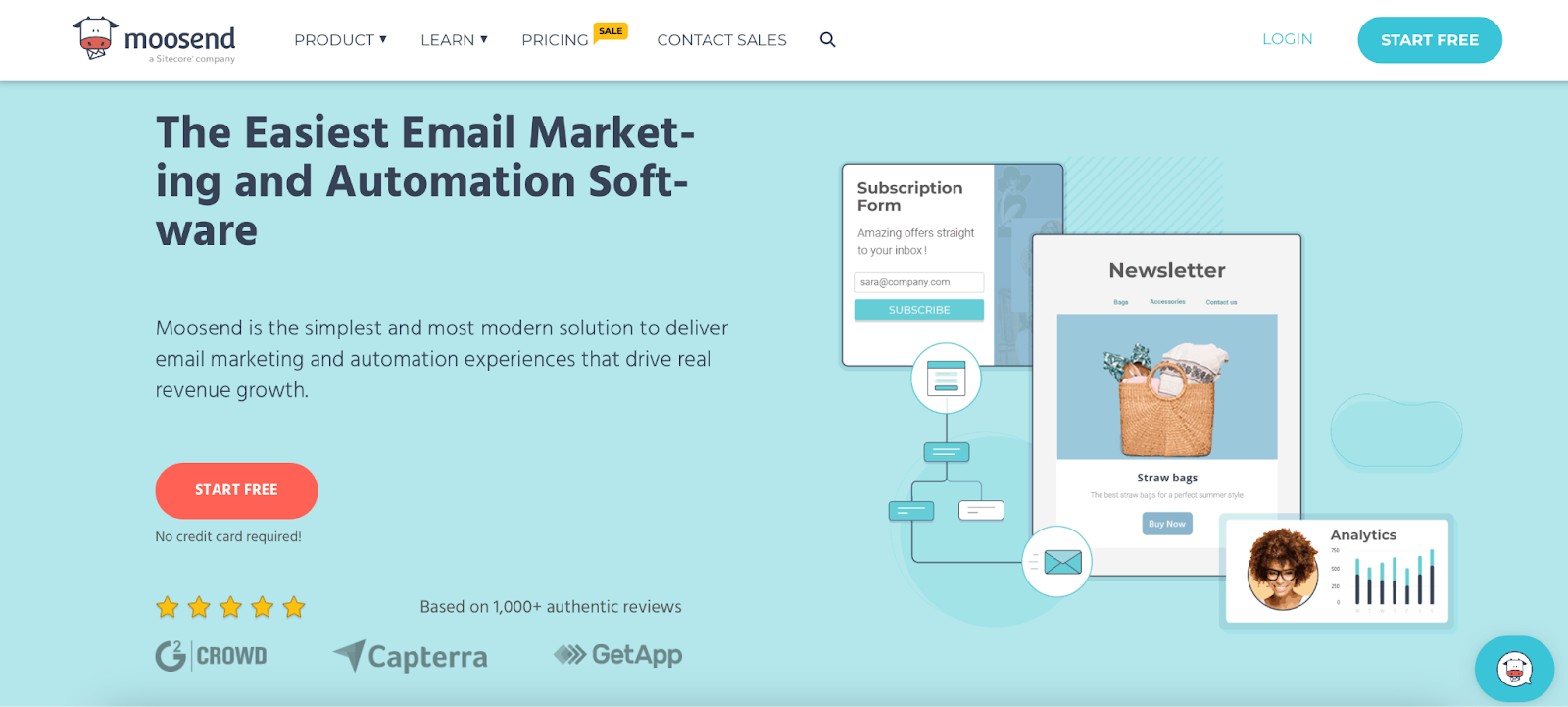
Moosend’s simple design and focus on key mass email marketing features make it a great option for startups with limited budgets. The platform lets you easily create eye-catching emails, set up automated email sequences, and design engaging landing pages.
The platform is known for its email personalization features, such as dynamic content blocks and merge tags. For automation, triggers include actions like website visits, email opens, or purchases. Moosend also offers email segmentation for better targeting, along with analytics and reporting tools to track key metrics like open and click-through rates.
Pricing
Moosend offers a 30-day free trial (not a free plan!) that includes unlimited emails to a 1K email list, 1 automation workflow, 1 landing page, and 1 subscription form. The Pro plan costs $ 5.60/mo for a list of 500 contacts and unlimited emails. Similar to other platforms, Moosend also offers frequent special deals, so check its pricing page to get up-to-date information.
Pros
- Unlimited emails even in lower-tier plans.
- Clear email automation workflows.
- Affordable pricing compared to other similar platforms.
Cons
- Moosend lacks the extensive integration options of some competitors, which might limit its compatibility with other tools startups may use.
- Access to priority support is reserved for higher-tier plans, which could be a drawback for startups requiring immediate assistance.
- Automation scenarios are limited compared to other similar tools.
Benchmark Email
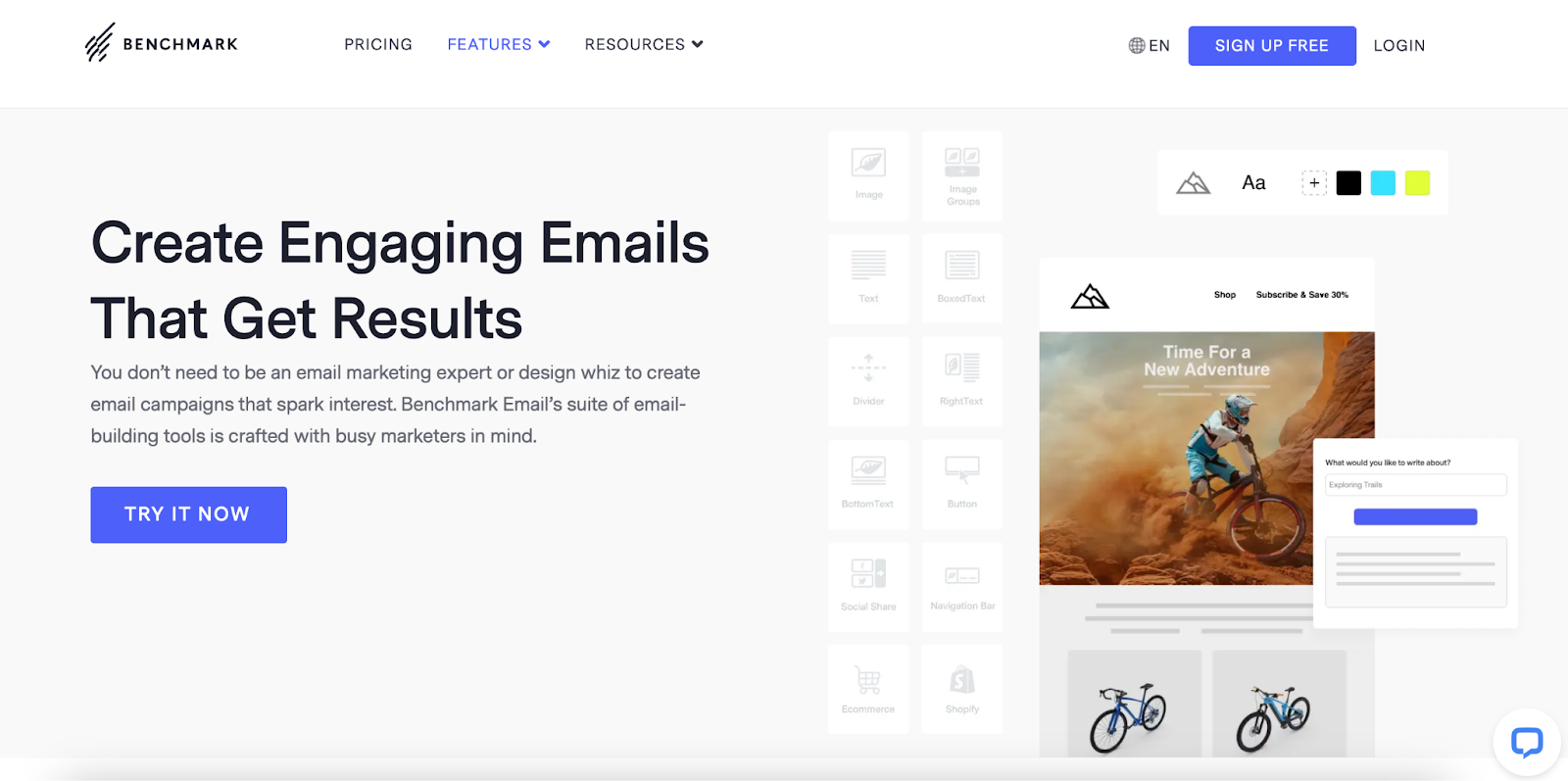
Benchmark Email is a practical email marketing tool for startups with limited time and resources. Its clean, intuitive design helps you create email campaigns, set up follow-up automation, and track performance without unnecessary complexity.
The platform’s key features include automated workflows, A/B testing, pre-designed templates, contact list management, autoresponders, and a wide range of integrations with popular apps.
Pricing
Its free plan allows you to send up to 3,500 emails per month to 500 subscribers to help you stay in constant contact with your audience. It includes basic tools but does not offer automation. The paid plan costs $13/mo and includes 7,5K emails, email automation, landing pages, and A/B testing.
Pros
- Autoresponders to reengage customers and get them back to your site.
- Simple interface.
- Includes tools to send surveys and polls to engage with your target audience.
Cons
- The free plan lacks advanced features like A/B testing and list segmentation.
- Limited functionality compared to competitors.
Mailercloud

Mailercloud is a user-friendly and affordable email marketing platform tailored for startups, small businesses, and growing teams. It focuses on delivering powerful features like automation, analytics, and deliverability without overwhelming users with complexity.
With Mailercloud, startups can set up advanced email automation using predefined flows and behavior-based triggers, helping them nurture leads and convert more prospects. Its drag-and-drop email builder allows users to create professional-looking, mobile-responsive emails in minutes — no coding required.
The platform also supports AMP emails, dynamic content, and A/B testing to boost engagement. For developers and advanced users, Mailercloud offers transactional emails via SMTP and RESTful APIs. It integrates easily with tools like Zapier, WordPress, Elementor, and Shopify, streamlining marketing and e-commerce operations.
Pricing
Mailercloud provides a free plan with 1,000 subscribers and up to 12,000 emails/month. Paid plans start at $7/month (billed annually), with access to premium automation, advanced analytics, and removal of Mailercloud branding.
Pros
- Clean, intuitive interface perfect for beginners and small teams
- Powerful automation workflows to engage users at every touchpoint
- High email deliverability with built-in optimization features
- GDPR-compliant with robust list management and segmentation
- API and SMTP support for sending transactional emails
- Responsive and friendly customer support team
Cons
- Limited third-party integrations compared to larger platforms
- Mailercloud is focused solely on email marketing; SMS and WhatsApp channels are not available
Wrapping up
Startups thrive on efficiency and precision, and Mailtrap delivers both with its all-in-one approach. Whether you’re testing your email setup or managing large-scale email campaigns, Mailtrap gives you the tools to control and optimize delivery without the usual roadblocks.
Unlike other tools that merely focus on deliverability, Mailtrap offers an infrastructure with high deliverability by default. Features like real-time analytics, spam checks, and authentication support ensure that emails consistently land in inboxes, giving startups a solid foundation for scalable email operations.
But don’t just take my word for it — try it for free and see how it compares to your expectations!
Want to explore more email marketing platforms? We have a dedicated video on our YouTube channel:



